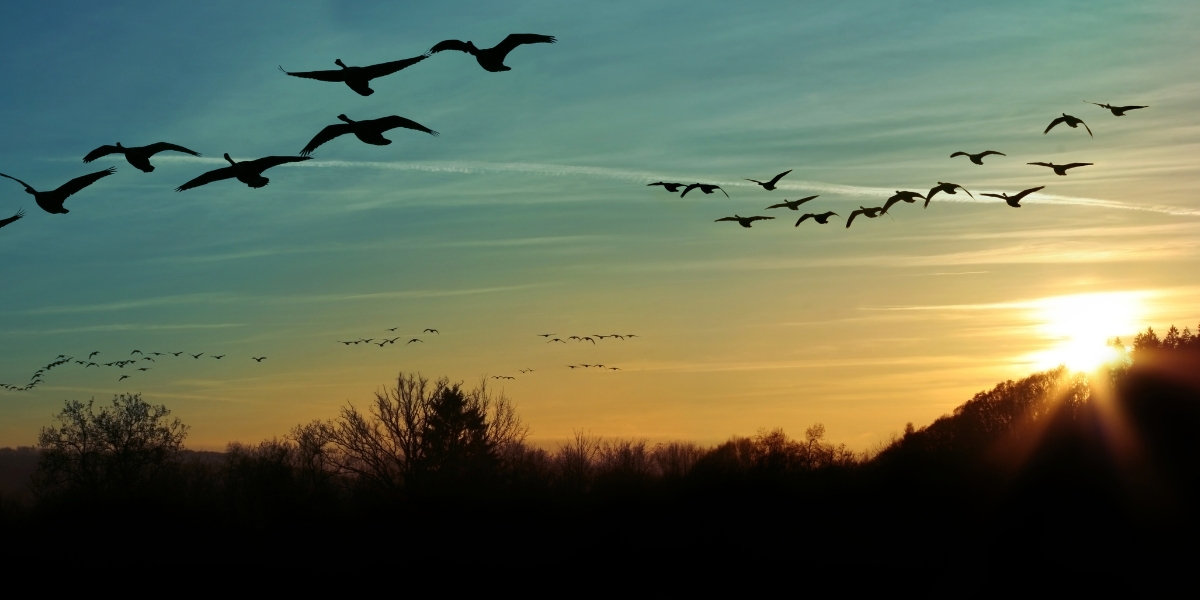Bird migration is in full swing! As autumn approaches, billions of birds are on the move between their northern breeding grounds and southern wintering habitats. The skies are filled with determined wings cutting through crisp air as birds stream southward. Ducks form lines and vees across moonlit horizons, while warblers flit through forests in mixed flocks. It’s a time of transition that reshapes populations across the continent.
For bird enthusiasts, fall migration brings a rush of excitement. Which routes are species taking? How can we support their journeys? What birds are migrating right now based on location and timing? Let’s explore the awe-inspiring phenomenon unfolding across North America’s diverse landscapes.
Overview of Bird Migration
Bird migration is an annual occurrence in which bird populations travel between seasonal habitats. It allows birds to take advantage of ideal nesting locations, abundant food, and suitable weather conditions at different times of the year.
Certain cues trigger birds to begin migratory behavior in spring and fall. Changing daylight length serves as the primary regulator of migration timing. As days shorten in late summer, hormonal shifts spur birds to fatten up and prepare for fall journeys south. Birds also use dropping temperatures, declining food sources, changing wind patterns, and more as signals to migrate.
There are four major flyways, or migration routes, that birds follow in North America:
- Atlantic Flyway: Along the Atlantic Coast [fws.gov]
- Mississippi Flyway: Through the Mississippi River Valley
- Central Flyway: From Mexico through the Great Plains
- Pacific Flyway: Along the Pacific Coast
Billions of birds funnel through these pathways twice each year. Now waves of migrants are in motion along these broad frontiers of travel.
Fall Migration Timeframes
Different birds migrate through various periods in autumn, depending on their optimal timing. Here’s a breakdown of migration windows:
Early Fall Migrants
Many shorebirds, swifts, hummingbirds, and swallows are early migrants, heading south as early as July from northern nesting sites. Most early migrants are done migrating by September, before conditions deteriorate.
- Semipalmated Sandpipers
- Black Terns
- Ruby-throated Hummingbirds
- Barn Swallows
Mid-Fall Migrants
Most songbirds migrate in September and October to take advantage of peak food resources on the breeding grounds before making their journeys.
- Warblers: Wilson’s, Northern Parula, Black-throated Blue
- Vireos: Philadelphia, Red-eyed, Warbling
- Flycatchers: Eastern Wood-Pewee, Eastern Phoebe
- Tanagers: Summer, Scarlet
Late Fall Migrants
Some birds wait longer to migrate south, departing northern areas in November or December. Late migrants are often those who arrived relatively early in the spring.
- Sparrows: American Tree, Fox, and Song
- Bluebirds
- Juncos
- Robins
- Yellow-rumped Warblers
This provides a general timeframe for migration peaks. But timing and routes can vary from year to year, even within a species, depending on conditions. Now let’s look at what’s on the move in different parts of North America.
What Birds Are Migrating in Each Region?
The cast of migrating birds changes throughout the fall and across the continent. Here are some highlights of who may be passing through at this time of year based on location:
Northeast
In September, watch for warblers like the Blackburnian, chestnut-sided, and bay-breasted. Scarlet Tanagers and Rose-breasted Grosbeaks move through forested areas. Scan marshes for Sora rails and pectoral sandpipers. Listen for the high-pitched “tseep” of migrating yellow-bellied flycatchers.
Southeast
American redstarts flit through woodland understories in September. Prothonotary warblers forage along forest streams and swamps. Watch overhead for migrating Broad-winged Hawks, Mississippi Kites, and Chimney Swifts. Scan mudflats for marbled godwits, willets, and migrating shorebirds at coastal refuges.
Midwest
Listen for loud kinglets and white-throated sparrows from Canada scratching through thickets. Check fields for Savannah Sparrows and Lincoln’s Sparrows. Hundreds of broad-winged hawks pass overhead on northwest winds. Marshes host Greater Yellowlegs, Lesser Yellowlegs, and Solitary Sandpipers.
Northwest
In August and September, Vaux’s Swifts gather by the thousands in evening communal roosts before migrating south. Watch for olive-sided flycatchers calling from tall treetops. American pipits and Pacific-slope flycatchers pass through on their way from mountain nesting sites. Wintering birds, like varied thrushes and rough-legged hawks, start arriving.
Southwest
Southbound migrants mingle with arriving winter residents. Violet-green Swallows, Black-headed Grosbeaks, and Bullock’s Orioles leave mountain nesting areas. Species like Audubon’s Warbler, Dark-eyed Junco, and American Kestrel move in for the winter. Expect an array of sparrows, including lark sparrows, black-throated sparrows, and vesper sparrows.
Now let’s go over some tips for identifying and observing which migrants are coming and going in your location.
How to Identify Migrating Birds
Here are some clues to help detect and identify birds actively migrating:
Behavioral Cues
Look for flocks, lines, or clusters of birds moving steadily in a common direction, often north to south. Listen for contact calls passed between migrating flocks, especially at night. Watch for birds to be more vocal and active early in the day to feed and move on.
Field Marks
Note if birds appear sleek and streamlined without breeding plumage, like bright colors or elaborate songs. Fat reserves and muscle mass contribute to power migration. Distinguish birds passing through from those arriving for winter.
Sounds of Migration
Many birds make distinctive flight calls while migrating at night. Apps like Flight Calls let users identify nocturnal migrants overhead. Also listen for contact notes and chips passed between birds migrating by day.
These are some of the telltale signs that migration is happening. Now let’s explore ways we can actively support migrating birds on their incredible journeys.
Supporting Migratory Birds
Here are some ways you can help provide resources for migrating birds:
Resources to Offer in Your Yard
- Fresh water – Birdbaths and drippers attract stopping birds.
- Food sources – Fruiting shrubs and seed/suet feeders provide fuel.
- Shelter – Trees, shrubs and brush piles offer safe resting spots and cover.
Citizen Science to Join
- eBird – Report sightings to track migration in real time.
- Project FeederWatch – Count feeder birds to monitor populations.
- NEXRAD Radar Migration – Interpret radar data to map nocturnal movements.
Conservation Groups to Support
- National Audubon Society – Protects critical habitats across flyways.
- American Bird Conservancy – Focuses on protecting and restoring bird populations.
- Local parks and nature preserves – Provide important stopover habitat.
Do your part to sustain migratory birds! Now let’s look at some of the amazing feats migrating birds undertake each year.
The Wonders of Bird Migration
Bird migration is a natural phenomenon full of marvels and mysteries. Consider some of these remarkable facts:
Amazing Migrations
- Arctic Terns complete a 60,000 mile round trip migration, the longest of any animal on Earth![https://www.allaboutbirds.org/news/how-far-do-birds-migrate-weve-got-charts-maps-and-more/]
- Ruby-throated Hummingbirds fly nonstop over the Gulf of Mexico up to 500 miles.
- Bar-tailed Godwits make a 7,000 mile nonstop flight from Alaska to New Zealand.
- Blackpoll Warblers may fly up to 1,700 miles nonstop over the open ocean during fall migration.
Importance of Stopovers
- Birds rely on stopover sites to rest and refuel during migrations. Major hotspots support millions of birds.
- Habitat loss at stopovers threatens migratory populations. Conservation is crucial to protecting these havens.
- Urban areas can also serve as migration stopovers when native plants and bird-friendly spaces are provided.
Changing Migration Patterns
- Climate change impacts migration timing and routes. Some birds are shifting earlier or later or taking new pathways.
- Migrating at the wrong time can cause birds to miss ideal food resources. These mismatches may impact populations.
- Tracking technology continues to reveal new insights about migration timing, routes, night navigation, and more.
The more we learn about bird migration, the more outstanding it becomes. Now let’s focus on how to fully enjoy this magical seasonal phenomenon.
Enjoying the Migration Spectacle
Here are some tips for making the most of the fall migration:
Hotspots for Birdwatching
Visit noted regional migration hotspots for the best chance of seeing a wide array of species funneling through. Coasts, wetlands, forests, and ridges offer prime migrant habitat.
Apps and Tools to Use
Resources like eBird, weather radar, BirdCast, and flight call libraries can help pinpoint migration activity in real time.
Ethical Considerations
Be respectful by keeping distance, avoiding disruption, and properly identifying birds before sharing rare sightings. Prioritize conservation.
Wherever you live, take time to appreciate the passage of migrating birds gracing your area for a temporary stay as they tenaciously carry on their journeys.
Conclusion
Fall bird migration is underway! The summer residents are departing, winter visitors are arriving, and billions of birds are in transition across North America. By understanding migration patterns, supporting migratory populations, and engaging through birdwatching and conservation, we can help sustain this extraordinary seasonal phenomenon. Use the regional tips and resources provided to discover what birds are passing through your area and the wonders of migration happening in your own backyard.

